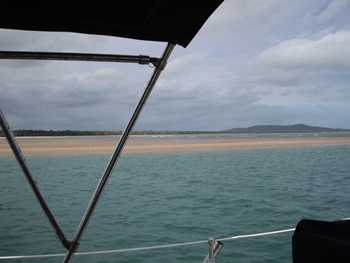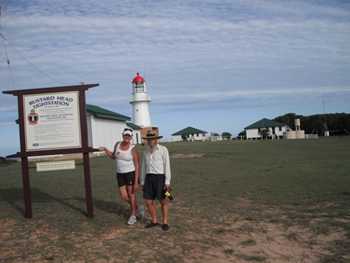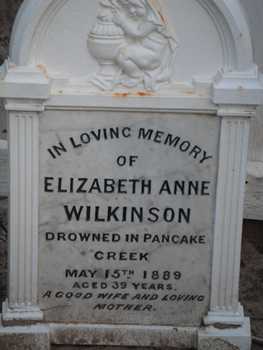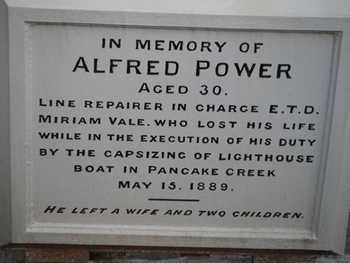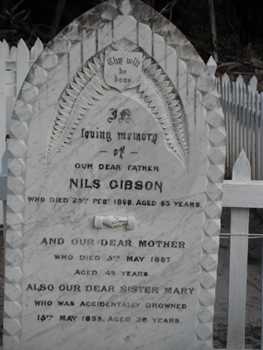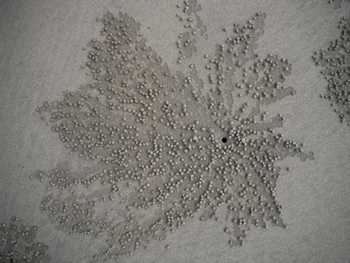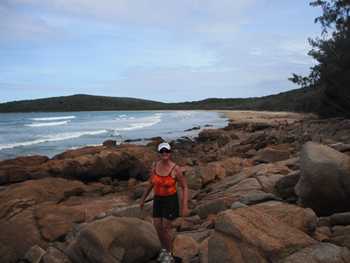Pancake Creek, Australia

Peregrina's Journey
Peter and Margie Benziger
Thu 20 Jan 2011 04:45
Position Report - 24⁰45’.621S 153⁰23’.278E
We are cruising down the Curtis Coast of southeastern
Australia. It’s Nov. 16th and
we’re in Queensland, the second largest state with 22.5 percent of the nation’s
total area, heading south to Brisbane.
The Great Barrier Reef begins here and it stretches all the way north to
the Torres Straits in the Gulf of Papua.
We’ll get back up that way in a few months but, right now, we are
heading south to placate our insurance company who would prefer that we be
south of 26⁰30’ latitude during Cyclone Season, December 1-March 30th.
The inner passage between the barrier reefs and the mainland
that we are following is definitely an exercise in adventure. The water is deep enough in most places –
even for the 6’2” draft on Peregrina.
It’s the tides that get you into trouble here! The difference between high and low tide can
be up to 18 FEET! If we were from Maine,
this wouldn’t be such a big deal but Florida has relatively little tide change. It’s enough to say, we weren’t used to timing
our arrivals and departures according to the twice daily highs and lows - not
to mention the phases of the moon or the season of the year! Yikes!!!
Where are all those tide tables when we need them???
Luckily, the many islands, reefs and inlet creeks that dot
the coast allow cruisers to daysail from one anchorage to the next. Night sailing is rarely necessary and that’s
a good thing. We learned that lesson
upon arrival in Pancake Creek a few days ago – ALMOST the hard way!
We were completing a long passage from Great Keppel Island
to Pancake Creek, a distance of about 60 miles and a long 12 hour day. It was getting dark as we entered the
anchorage at low tide through a very narrow channel and we were having trouble
seeing the buoys that mark the encroaching sandbar. Our chartplotter showed
that the creek was not surveyed for depth so all eyes were on the depthmeter to
determine how much water we had below the keel.
As the numbers dropped steadily to 5..4..3..2..1 foot and then inches,
we held our breath and, at 3 inches, it was time to reverse ASAP!!!
Turns out, the starboard buoy at the entrance of the creek
had “gone missing” (as the Aussie’s say) within the past day or two and we were
MUCH too close to shore! Once we got our
bearings, we proceeded to the anchorage with no further problems but it was a
close call. Had we actually run aground,
we would have been stranded for several hours before high tide floated us free.
Anyway, once we were settled in, Pancake Creek turned out to
be a great spot for a 3-night stay. We
did a lot of hiking along the coastline and up to the beautiful Bustard Head
Lighthouse (see photos) which has been in continuous service since 1868. Here, we met Warren, the volunteer site
manager (pictured above) and his wife, Marion, who invited us in for tea. They maintain the grounds and the little Bustard
Head Lighthouse Association museum for
two months every year. The Lighthouse,
itself, is operated by the Australian Coast Guard.
Warren showed us the way to a small cemetery where we
checked out the tombstones of several of the former lighthouse keepers and
their family members. Surprisingly, most
of the inscriptions indicated that death had been due to drowning! You would think that proficiency in swimming
would be one of the key elements in the job description, wouldn’t you?
Back down from Bustard Head, we hiked along Aviation Beach,
where we took a photo of the unusual sand ball “artwork” that covered the
beach. Turns out, these sand balls,
literally hundreds of thousands of them, are formed by Sand Bubbler Crabs who
live on the beaches here in the tropical Indo-Pacific. They don't roll the balls with their claws,
but make them in their mouths while sifting the sand for food during low tide.
When they've finished eating, they spit out these little pellets which end up
forming intricate patterns all over the beach.
They can sift through the surface of an entire beach during low tide. The pellets are then swept away with the
rising water at high tide and they start all over again. There are all sorts of weird stories about
“whackos” who see images of Jesus and John Lennon in the sand but it’s really
just and “eat and spit” reflex. Paste in
the link below or just Google Sand Bubbler Crabs and go to the videos)…it’s
pretty cool!
http://www.google.com.au/url?sa=t&source=web&cd=1&ved=0CBkQtwIwAA&url="" size="2">
On the way back, we tried to bushwhack our way over a hill
which I figured out would be a short cut to the boat. It wasn’t that far to the top but it was
steep and the brush was pretty thick. I
found what looked like a path of sorts and ran ahead of Peter. However, it led into more tangled bushes and,
with memories of that Eastern Brown Snake that we encountered back in Mackay, I
lost my nerve and decided to turn back.
Just as I whipped around, this HUGE kangaroo came hopping
out of nowhere and plopped himself right down in front of me! I don’t know who was more surprised but I
froze as I realized I was cornered face-to-face, six feet apart from a
marsupial who was tall enough to look me in the eye when he straightened
upright. Hopefully, he hadn’t taken
boxing lessons as a youth! A long moment passed as we eye-balled each other. My vocal cords were paralyzed…I’m not sure
about his…and then he turned and hopped back into the underbrush.
No, I don’t have a photo of this close encounter with
Captain Kangaroo as he was gone before I could summon up the audibles to call
for Peter. However, my story was
validated with the discovery of several large footprints clearly indicating
four toes, including two tiny ones used for grooming and a third, huge toe with a
strong, sharp claw that can be used as a weapon (YIKES!!!).
Yes, I’ve researched my furry friend and found out some other
interesting facts…There are fourteen species of living kangaroos in Australia
and they belong to the genus Macropus/family Macropodida, meaning
"big footed." They are mainly
herbivorous, or plant-eating…lucky for me!
The “Captain” was, most likely, an Eastern Gray Kangaroo which are found in the forested areas throughout the eastern half and the southwest region of the continent. These kangaroos are often called "living pogo sticks." The gray kangaroo has been known to jump up to 30 feet long and 6 feet high. But, for the most part, a kangaroo tends to move in a leisurely fashion using all four feet plus its hefty tail for balance.
Let’s talk about sex, baby! Well, maybe just the baby part. After all, this IS a General Audience-rated email…. For such a large animal the gestation period is incredibly short. The baby (known as a joey) is born after only 38 days. It is less than an inch long, blind, and hairless like the newborns of all marsupials.
The “Captain” was, most likely, an Eastern Gray Kangaroo which are found in the forested areas throughout the eastern half and the southwest region of the continent. These kangaroos are often called "living pogo sticks." The gray kangaroo has been known to jump up to 30 feet long and 6 feet high. But, for the most part, a kangaroo tends to move in a leisurely fashion using all four feet plus its hefty tail for balance.
Let’s talk about sex, baby! Well, maybe just the baby part. After all, this IS a General Audience-rated email…. For such a large animal the gestation period is incredibly short. The baby (known as a joey) is born after only 38 days. It is less than an inch long, blind, and hairless like the newborns of all marsupials.
The joey has
virtually no hind legs at all when born. It’s relatively powerful front claws pull
the tiny creature through its mother's fur and into her pouch, where her teats
are located. Once the baby's tiny mouth clamps onto a teat, the infant, now
called a pouch embryo, cannot let go even if it wants to. It will be a month or
more before its jaw develops enough to open.
The pouch embryo
will continue to develop as it would if it were inside a uterus. Most of the
big kangaroos will spend 10 months or more before the joey emerges for the
first time (often falling out by accident). It gradually comes out for longer
and longer periods, staying by its mother's side until it is about 18 months
old. On average, kangaroos live between
15-20 years. So now you know…
